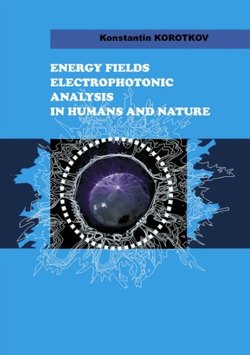Читать книгу Energy Fields Electrophotonic Analysis In Humans and Nature - Konstantin M.D. Korotkov - Страница 22
На сайте Литреса книга снята с продажи.
Can this emission take place without an electric field?
ОглавлениеYes, this emission can happen without an electric field, and such an emission is called ‘spontaneous.’ Measuring a spontaneous emission of electrons in the air is nearly impossible – it can only be done in a vacuum. Spontaneous emission of photons can be measured with the aid of a highly sensitive photomultiplier. This emission was measured for the first time by Professor Alexander Gurvich in the 1930s. He proved that the exchange of ultraviolet photons is the method used by biological systems to regulate information. Currently, the area called ‘biophotonics’ is researching extremely weak photon emissions from biological objects. Much of the research done has shown that photons are emitted by any biological object: plants [Kobayashi, 2003], blood and water [Voeikov, 2001], human skin [Cohen, Popp, 1998]. The quantity of photons emitted by the human head in a relaxed state and during meditation varies, and these variations are statistically reliable! [Van Wijk, et al, 2005]
Therefore, it has been categorically proven that all biological objects emit photons, and these photons participate in the processes of physiological regulation, and most importantly in oxidizing restorative chain reactions. In other words, all biological objects, including humans, are glowing both day and night!
Biological life depends on using the energy of photons from the sun. This energy is converted into electron energy by photosynthesis in plants. Through a series of transformations in complex chains of albuminous molecules this light energy is converted into our body energy. Thus, biological life is based on light energy, and organic compounds serve as the working material for the conversion of this energy. The basic ingredients for all conversions are water and air [Korotkov et al., 2004].
Consequently, we are all children of the Sun, living on the light of the world, and we ourselves emit light!
Yet the registration of ‘biophotons’ – spontaneous photo-emission – is an extremely complex procedure requiring special conditions, the most important of which is total darkness. Until the measurement begins, people being tested spend an hour in a room illuminated with a dark red light, after which they are put in a totally dark chamber, where they will remain for a further 10 minutes in total darkness until the measurement starts. This elaborate process should eliminate any ‘secondary luminescence’ from the cutaneous covering following radiation by the sun or artificial light. The measurement process itself takes up to 45 minutes [Edwards et al., 1989]. So the process of measuring spontaneous photo-emission is very complex and long. Such measurements require a special and unique device, and can be accomplished only under specialized laboratory conditions.
The data obtained when measuring extremely weak ‘biophotons’ is invaluable scientific information, highlighting the role of electro-photon processes in the functioning of the body. These results are part of the scientific basis for the justification of the physical processes of EPI Bioelectrography.
In the EPI/GDV method, we excite or stimulate electron and photon emission, and then intensify the resulting glow a thousand times. This makes it possible to take measurements under normal circumstances, with normal lighting, without special preparation of the objects.
All the information in the EPI method is obtained through computer processing of images and mass data. Without the methods of computer processing and specialized software, registering the glows of biological objects would be of no practical significance.
Therefore, EPI software is an integral part of the EPI system, and only by using EPI software is it possible to obtain complete information about the biological object carried by electrons and ‘biophotons.’
